Benefits of Toads in the Garden
Enhancing Natural Pest Control
When I noticed an increase in insect pests in my garden, I stumbled upon a natural solution that many gardeners overlook — toads.
Toads play a crucial role in maintaining a balanced garden ecosystem by preying on insects, slugs, and snails.
These garden helpers can consume up to 10,000 pests in a single summer, significantly reducing the need for chemical pesticides.
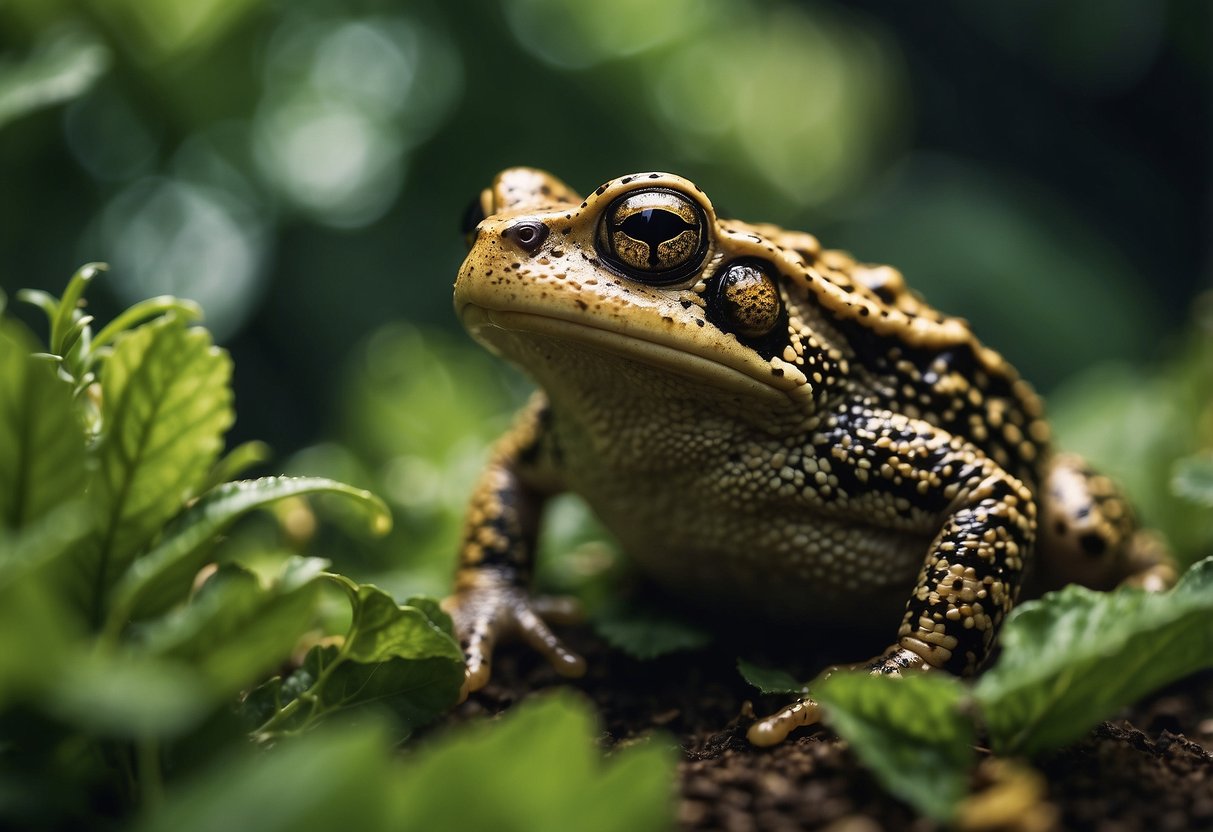
Unlike frogs, toads are well-adapted to living on dry land. Their dry, thick skin allows them to thrive in less moist environments, making them perfect for garden life.
In fact, having a diverse selection of fauna like toads can lead to increased biodiversity in the garden, which helps in keeping pest-related problems at bay.
Key Takeaways
- Toads consume thousands of pests, reducing the need for chemicals.
- They thrive in gardens with dry and shady spots.
- Increased biodiversity from toads leads to a healthier garden environment.
The Ecological Roles of Toads
Toads play vital roles in our gardens, significantly impacting pest control and enhancing biodiversity. These benefits contribute to healthier and more balanced ecosystems.
Pest Control
In my garden, toads are essential for managing pests. They consume large quantities of insects, many of which are harmful to plants.
I’ve noticed that common pests like beetles, slugs, and caterpillars are much less of a problem thanks to the toads.
By naturally controlling pest populations, toads reduce the need for chemical pesticides. This not only keeps my garden healthier but also safer for other wildlife and myself.
Additionally, toads are more active at night, hunting when many pests are most active, making them incredibly efficient.
Toads’ presence creates a natural pest control system, contributing significantly to the overall health of my garden. Fewer pests mean stronger, more vibrant plants, which is beneficial for both my garden’s productivity and its aesthetic appeal.
Biodiversity Enhancement
Toads also play a significant role in boosting biodiversity. Having them in my garden encourages a variety of other species to thrive.
Their presence indicates a healthy environment, which attracts various insects, amphibians, and even bird species that rely on a diverse ecosystem.
In addition, toads provide food for predators like snakes and birds, which adds another layer of complexity to the garden’s food web. This interaction ensures that no single species dominates, promoting a balanced and resilient ecosystem.
Moreover, toads help in seed dispersal indirectly. As they move through the garden, they distribute seeds stuck to their skin, aiding plant propagation and diversity. This enhances the variety of plants, creating a richer habitat for numerous organisms.
Toads are critical in maintaining ecological balance, making the garden a more vibrant and dynamic place.
Gardening Benefits From Toads
Toads play a crucial role in the garden by providing natural fertilization, aerating the soil, and even aiding in plant pollination. Here’s a closer look at these important contributions.
Natural Fertilization
Toads contribute to natural fertilization through their droppings. These droppings are rich in nitrogen and other essential nutrients.
As toads eat a variety of insects and pests, their waste helps fertilize the soil, promoting healthy plant growth.
In my garden, toad droppings have noticeably enhanced the nutrient content of the soil. This has resulted in healthier and more vigorous plants.
By relying on toads for this natural process, I reduce the need for chemical fertilizers, which helps maintain an eco-friendly environment.
Soil Aeration
Toads also help with soil aeration. Their burrowing activities create small tunnels in the soil, which improve its structure and increase airflow.
Better soil aeration allows roots to grow more easily and access the oxygen they need.
I’ve observed that areas of my garden frequented by toads tend to have softer, more fertile soil.
This aeration effect is particularly beneficial for root vegetables like carrots and potatoes. They grow larger and healthier with more oxygen reaching their roots.
Plant Pollination
Although toads themselves do not pollinate plants, they create an environment that supports pollinators.
By reducing the number of harmful insects and pests, toads indirectly benefit pollinators like bees and butterflies. This leads to improved pollination of flowers and plants.
In my garden, the presence of toads has resulted in more blossoms and a significant increase in fruit and vegetable yields.
Maintaining a habitat that attracts toads ensures that pollinators can thrive, leading to better crop production and a more vibrant garden.
Toad Habitats and Garden Health
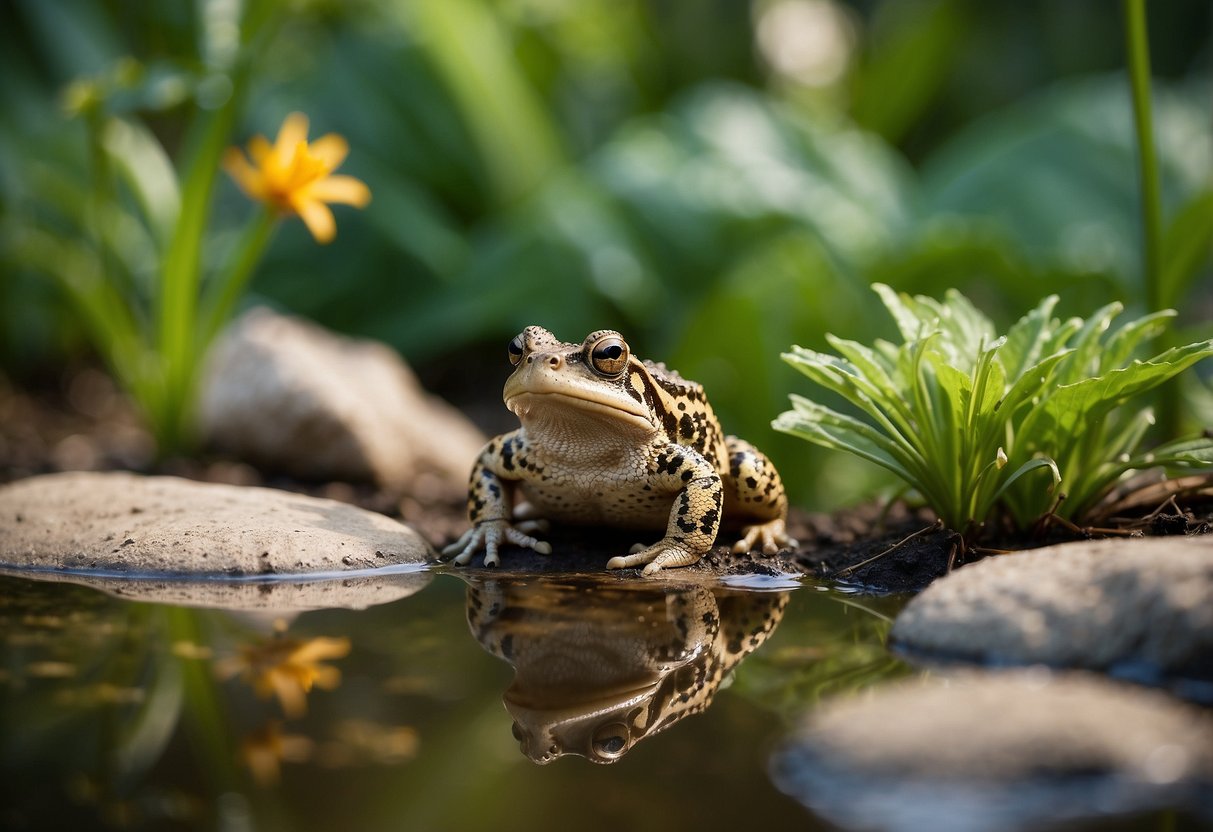
Toads play a crucial role in gardens by controlling pest populations and contributing to ecosystem balance. Creating a welcoming habitat for toads and maintaining garden health can ensure these benefits.
Creating Toad Habitats
To attract toads, I need to provide the right environment.
Toads prefer cool, moist places with plenty of shade. I can identify a secluded spot in my garden that has low foot traffic and some natural cover.
Adding native plants helps. They attract insects, which are a toad’s main food source. This creates a self-sustaining mini-ecosystem.
Furthermore, toads need hiding spots to escape predators. I can place boards, loose rocks, or even garden decorations like toad houses around the garden.
Moisture is essential. I might add a shallow water dish or create damp areas by mulching or watering certain spots more frequently. This ensures toads have access to the moisture they need.
Maintaining Garden Ecosystems
Maintaining a healthy garden ecosystem is important for keeping toads around.
Healthy soil with a variety of microorganisms supports plant growth and insect populations, providing food for toads.
I should avoid using chemical pesticides and fertilizers, as they can harm toads and their food sources.
Native plants are vital for a thriving ecosystem. They support local insect populations, which in turn provide food for toads.
Choosing a variety of native plants can make my garden more appealing to toads and beneficial insects.
Creating diverse habitats within my garden is key.
Different plants, rocks, and water features can support various types of wildlife, not just toads.
This diversity helps build a resilient ecosystem that can withstand pests and diseases without relying on chemicals.
Human and Toad Interactions
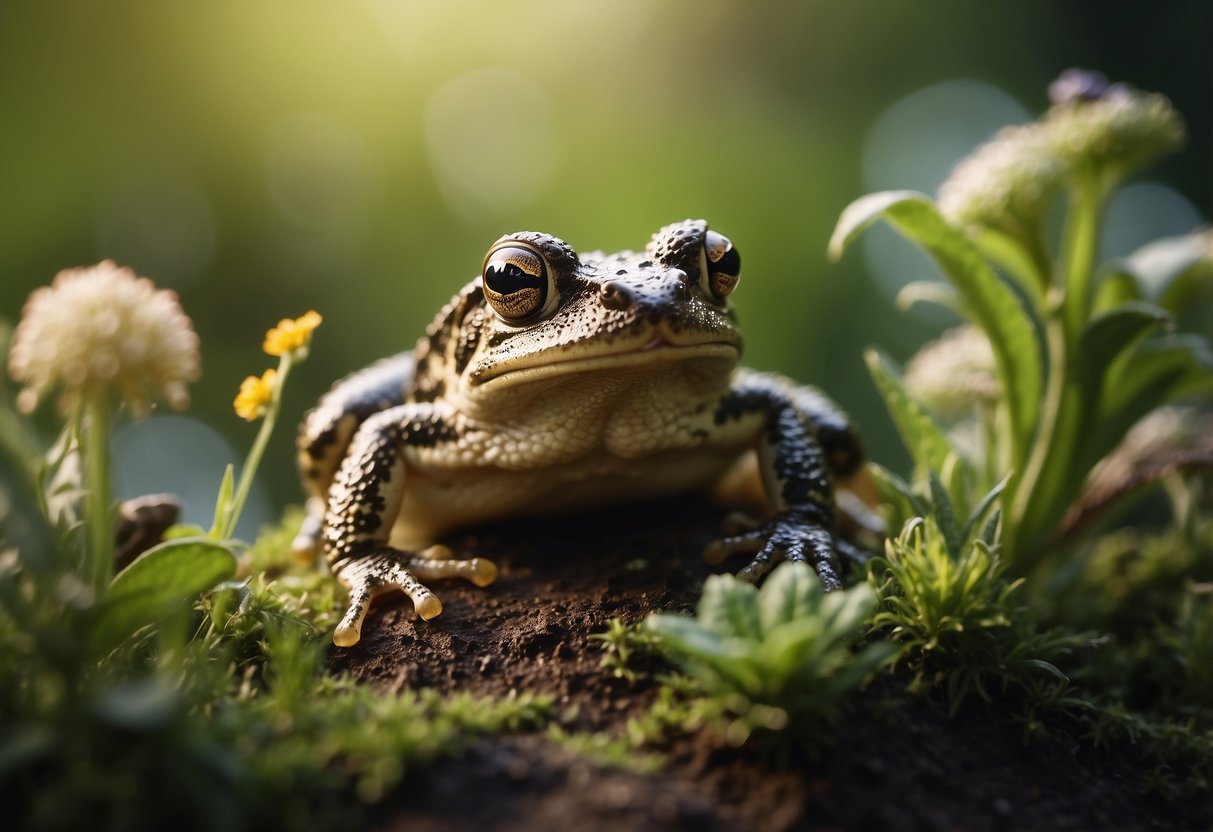
Toads in the garden can foster educational opportunities and enhance personal well-being, making gardening more enjoyable for everyone involved.
Educational Opportunities
Toads provide fascinating opportunities for learning, especially for children.
Observing toads in their natural habitat can teach kids about amphibian life cycles, ecosystems, and food chains.
Schools and nature enthusiasts can also use toads for hands-on lessons. Identifying different types of toads and understanding their behaviors helps foster curiosity and respect for wildlife.
Gardeners may learn how to create a more toad-friendly environment, such as maintaining damp areas or providing hiding spots like logs or rocks.
Such activities promote a sense of stewardship for the natural world.
Engaging with toads can transform a simple garden into an outdoor classroom, making learning fun and interactive.
Wellness and Garden Enjoyment
Toads contribute significantly to garden enjoyment and personal well-being.
Their presence helps reduce pests naturally, minimizing the need for chemical pesticides. This not only makes the garden healthier but also provides a more pleasant experience for the gardener.
Watching toads hop around or hearing their calls can add to the peaceful ambiance of a garden.
This peaceful atmosphere can reduce stress and promote relaxation.
Additionally, knowing that your garden supports local wildlife can provide a sense of accomplishment and connection to nature.
Including elements like small ponds or water dishes can attract toads and enhance garden ecosystems.
I find that sharing these wildlife-friendly spaces with family and friends can also strengthen social bonds and create memorable outdoor experiences.
To learn more about the benefits of toads, you can visit Birds and Blooms or Gardening Know How.
Protecting Toad Populations
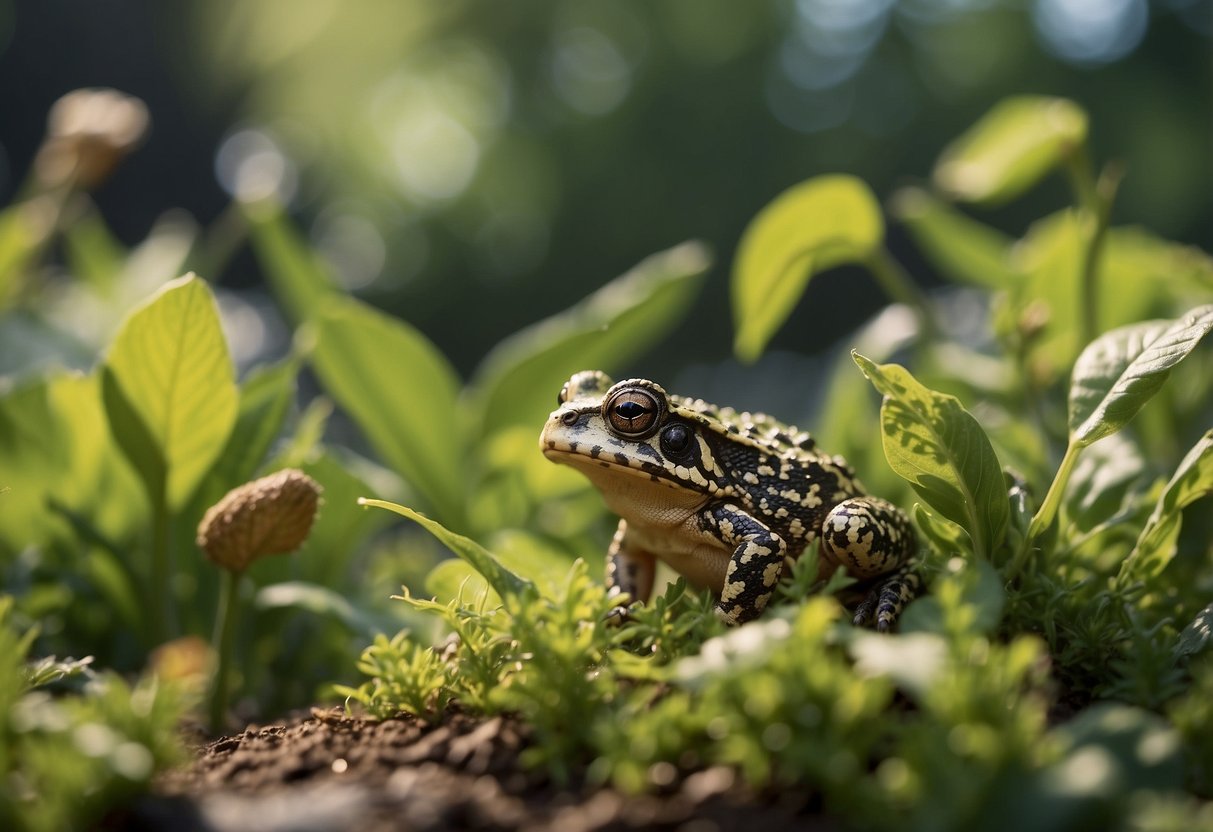
Protecting toad populations in gardens involves understanding different toad species and taking part in conservation efforts. Toads are vital for controlling pests and maintaining a balanced ecosystem.
Understanding Toad Species
Knowing the types of toads in your area is important for their protection. Different toad species have unique needs and behaviors.
For example, the American toad, common in the U.S., requires moist environments and plenty of insects.
European toads, on the other hand, prefer areas with dense vegetation.
It’s essential to provide suitable habitats for these species by keeping gardens naturally diverse. Avoiding chemicals like pesticides can prevent harming their sensitive skin.
Habitat loss is a major threat to toads.
Building small ponds or water features can help, as toads need water for hydration and breeding.
Providing hiding places with rocks, logs, or dense plants can give them shelter from predators.
Conservation Efforts
Engaging in conservation efforts can make a big difference.
Supporting local wildlife organizations that focus on amphibians is a great way to start.
These groups often work on habitat restoration projects and breed and release programs for endangered toad species.
Educating others about the importance of toads is also crucial.
Informing neighbors and community members about the benefits of toads and how to protect them can lead to broader conservation actions.
Another way to contribute is by creating “toad-friendly” gardens.
This includes preserving native plants, reducing lawn areas, and maintaining clean water sources.
Keeping cats and dogs away from toad habitats can also reduce the risk of predation.
By making simple changes, I can ensure toad populations thrive in garden environments.
Integrating Toads Into Garden Design
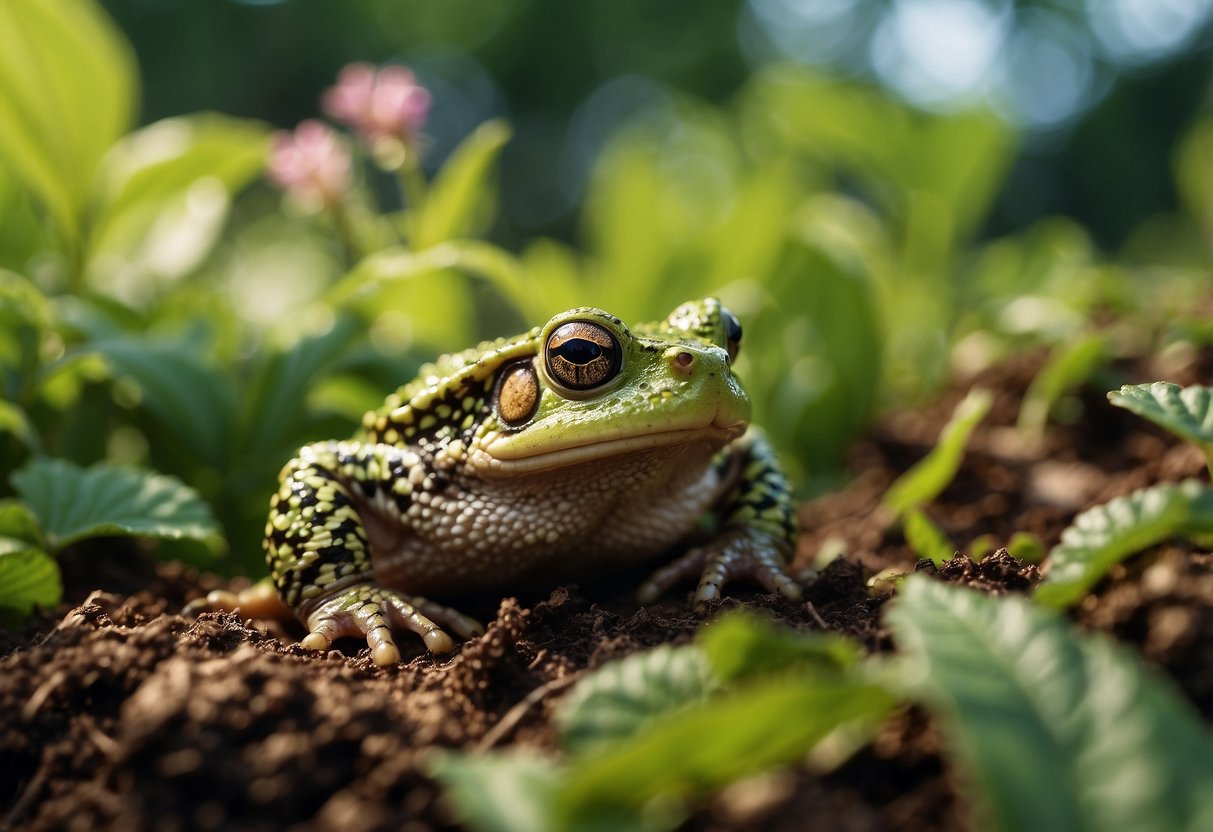
Creating a garden that welcomes toads involves not only enhancing its aesthetic appeal but also selecting plants that benefit these amphibians.
Garden Aesthetics
Incorporating toads into garden design starts with creating visually appealing yet functional elements.
A shallow water feature can be both attractive and beneficial for toads. They need water for hydration and breeding. A small pond or a saucer of water can serve this purpose well.
Adding natural hiding spots like rock piles, logs, or purpose-built toad houses can further beautify the garden. These spots also provide safe spaces for toads to take shelter.
Ensuring these features blend seamlessly with the rest of the garden maintains the visual appeal while serving the needs of toads.
Paths lined with native grasses and flowers not only enhance the look but also provide moisture and cover.
I can also use garden decorations, such as ceramic toads or decorative stones, to create an inviting environment for both toads and visitors.
Toad-Friendly Plant Selection
Choosing the right plants is crucial for a toad-friendly garden.
Toads require shaded areas and moist environments. So, selecting plants that provide cover and maintain soil moisture helps create a suitable habitat.
Ferns, hostas, and other shade-loving plants can create an ideal environment for toads.
Plants that attract insects are also beneficial as they provide a food source for toads.
Consider planting native wildflowers and grasses to support insect populations. Avoid plants that need heavy chemical pesticides since toads can be harmed by these substances.
Incorporating a mix of ground covers, shrubs, and flowering plants can help maintain a balanced ecosystem. These plant choices ensure toads have diverse habitats and food sources, promoting their health and well-being in the garden.
Frequently Asked Questions
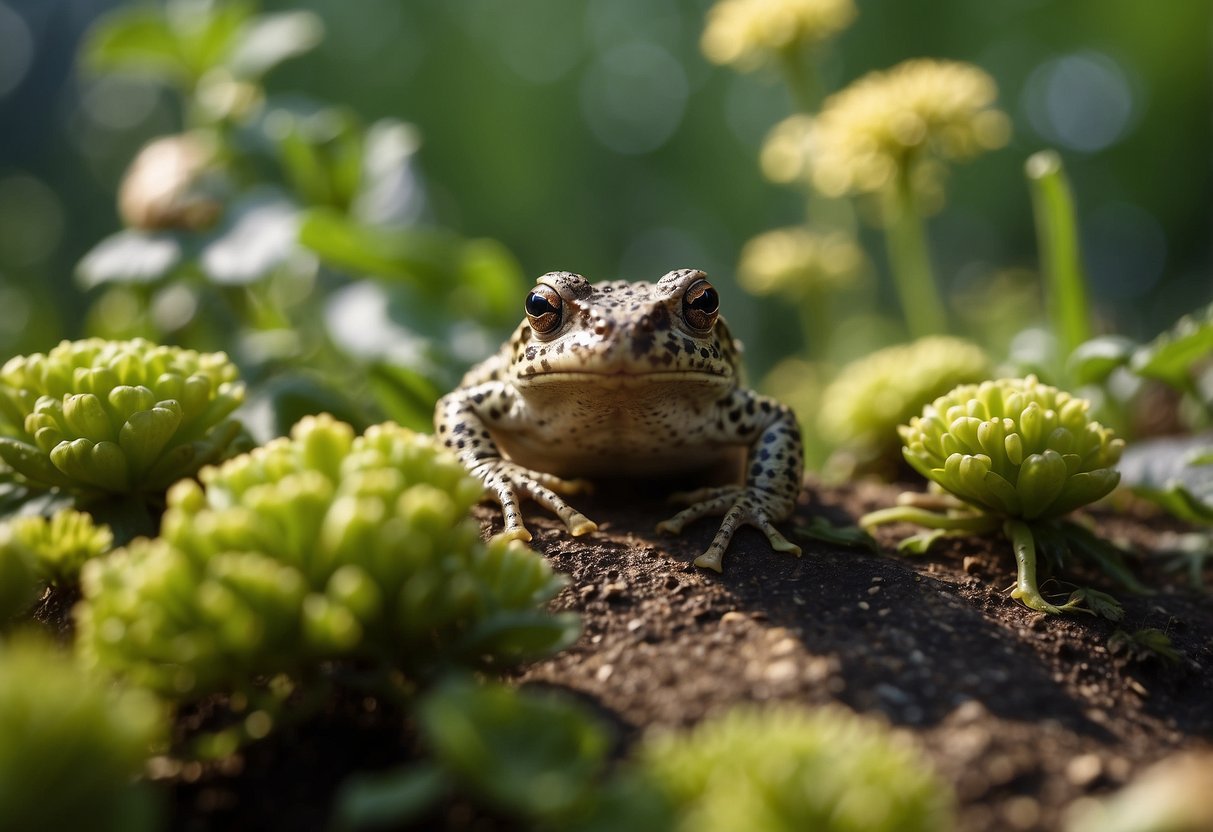
I often get questions about the benefits of having toads in a garden. These creatures play crucial roles in maintaining garden health, pest control, and ecological balance.
How do toads contribute to garden health?
Toads help maintain garden health by eating insects and pests such as slugs and snails. This natural pest control reduces the need for chemical pesticides. Toads also improve soil quality with their burrowing activities, which aerate the soil and benefit plant roots.
What methods are effective for attracting toads to a garden?
To attract toads, ensure your garden has a clean water source like a shallow pond. Create moist hiding spots under boards, rocks, porches, and tree roots. Avoid using chemical pesticides and fertilizers. You can also make decorative toad homes to provide suitable shelter.
Are there any risks associated with having toads in residential gardens?
One risk is that toads can be harmed by garden chemicals, so it’s important to use organic methods. Predators like cats and dogs may also pose a threat to toads. Additionally, water features can become breeding grounds for mosquitoes if not properly maintained.
What can I do to support toad populations in my garden?
Provide clean water sources for toads to breed. Create moist, shaded areas for shelter. Plant native vegetation to attract insects and other prey. Avoid using chemical pesticides. Building small ponds or water gardens a foot or more deep can also help support toad populations.
Can introducing toads to my garden benefit pest control?
Yes, introducing toads can greatly benefit pest control. Toads consume large numbers of garden pests, including beetles, caterpillars, and ants. This reduces the need for synthetic chemical pest control methods, which can be harmful to other wildlife in your garden.
How does the presence of toads indicate the ecological balance of a garden?
The presence of toads usually indicates good ecological balance. They rely on a healthy environment with plenty of prey. A diverse spread of native plants and animals in your garden can help ensure that toads thrive. This, in turn, signals a healthy, self-sustaining ecosystem.
